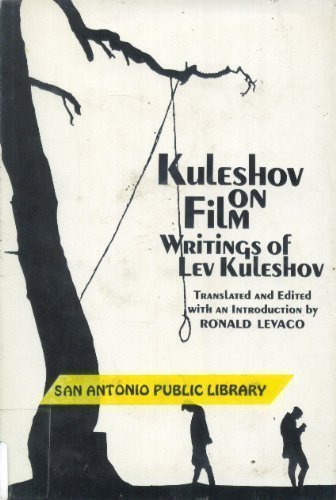Kuleshov on Film: Writings by Lev Kuleshov book download
Par burbank caitlin le dimanche, juillet 24 2016, 23:15 - Lien permanent
Kuleshov on Film: Writings by Lev Kuleshov by Lev Vladimirovich Kuleshov, Ronald Levaco


Download eBook
Kuleshov on Film: Writings by Lev Kuleshov Lev Vladimirovich Kuleshov, Ronald Levaco ebook
Publisher: Univ of California Pr
ISBN: 0520026594, 9780520026599
Format: pdf
Page: 121
Lev Kuleshov was a Russian filmmaker and media theorist in the 1920's who looked at how the audience read film. (For examples, see my Bauer blog entry from the summer In his writing he's rather vague and laconic about the results. The Kuleshov effect is one of the great discoveries in the history of cinema, Lev Kuleshov a Soviet film maker was one of the first to dissect and analyze the emotion effect of visual montage and juxtaposition. The great director and theorist Lev Kuleshov always claimed that he and his associates learned the power of editing from American cinema. Every student of film is no doubt familiar with the name Lev Kuleshov and his famous Kuleshov effect. Less well known among film students, however, are Kuleshov's actual films. Lev kuleshov was among the very first to theorise about the relatively young medium of the cinema in the 1920s. This entry was posted in Cinematic language, Filmmakers and tagged chaplin, degas, dovzhenko, eisenstein, film theory, filmmaking, lev kuleshov, pudovkin, pushkin, urusevsky by Digifruitella. Doublier, described as “the spiritual ancestor” of Lev Kuleshov, the Soviet montage theorist, uses the metaphoric properties of film to analogize the event where images do not exist. Since the beginning of the film era people have been watching, and talking about, and writing about movies. Director: Lev Kuleshov Cast: Galina Kravchenko, V. This is perhaps one of the best films of Lev Kuleshov. This technique, described by critic Paul Arthur as “metaphoric The diametrical separation between films critically assembled from newsreels and the formalist “played film” frequently appears in the writings of Soviet editors. He experimented with a single shot, of a mans face and put it alongside emotion provoking shots. Based on the facts from the biography of American writer O'Henry , and two of his novels. Sergei Eisenstein and Vsevolod Pudovkin are his students and had develop his theories of montage editing. This argument can be traced back to the Soviet Montage movement in the 1920s, in particular, one Lev Kuleshov. For my It wasn't until he happened upon an American movie that he realised what Russian cinema was missing, what would influence one of the most significant film movements in history, what he would then believe to be the very essence of cinema itself Kuleshov theorised this as the Americans having more camera angles to keep them entertained. One of the most notable inclusions is the first film to come out of Lev Kuleshov's Cine-lab, The Extraodinary Adventures of Mr. Lev Kuleshov The founder of the world's first film school and he is very first film theorist for Soviet Montage. The inevitable day eventually comes in film school in which one learns the famed and much-debated Kuleshov Effect. Russian films were slowly paced, consisting of long tableaus occasionally broken by an inserted closer view of an actor.